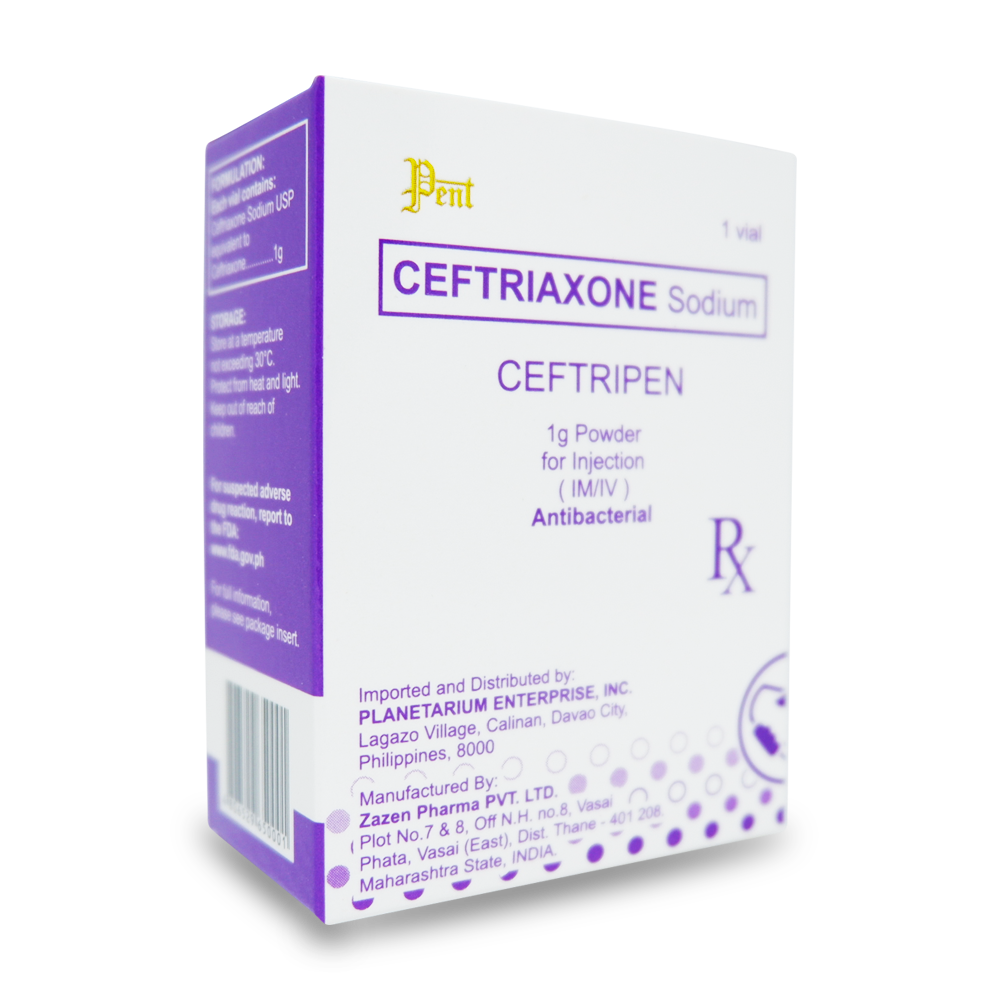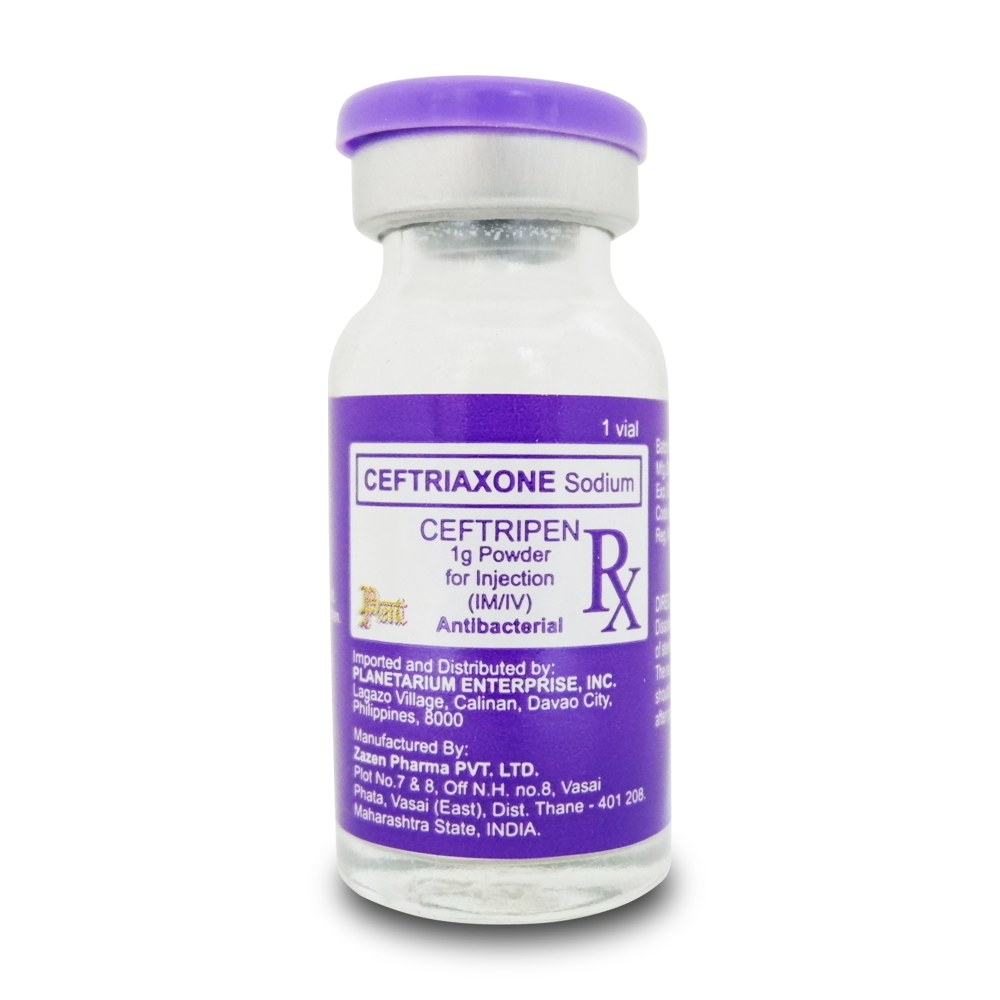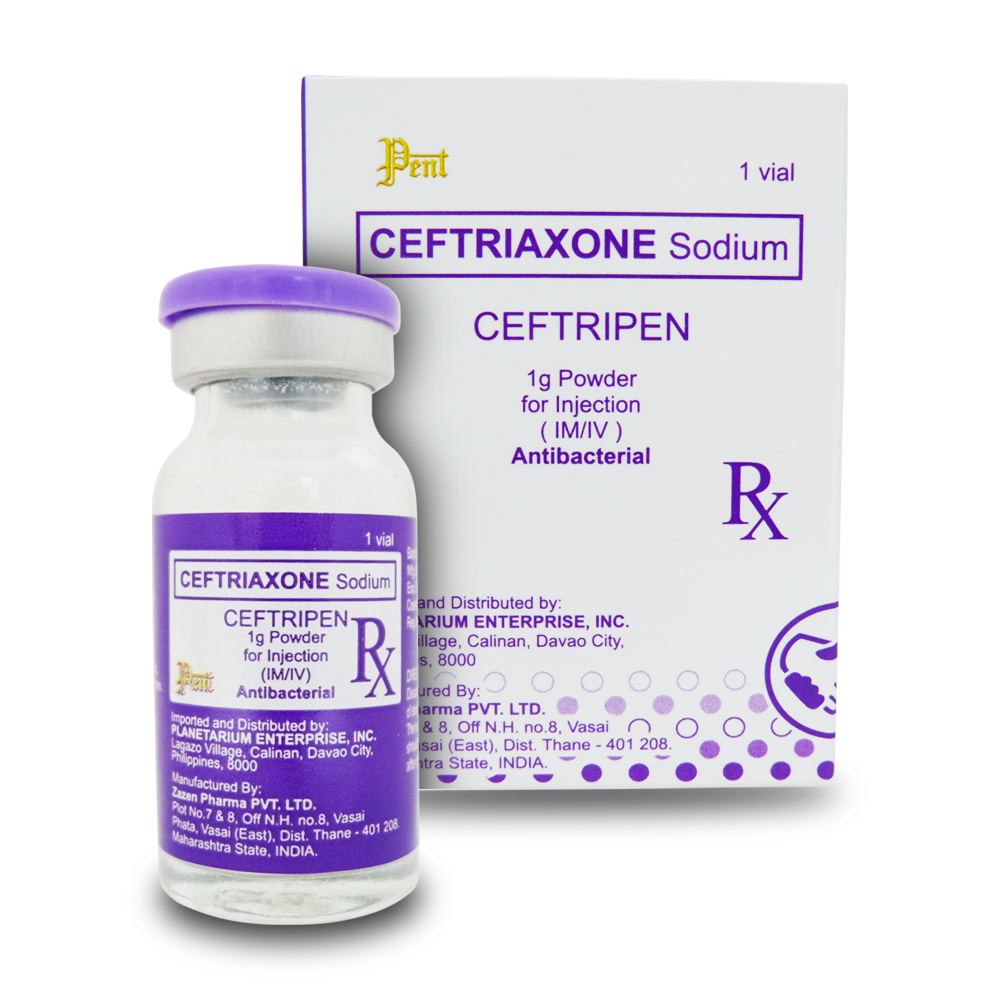



Generic Name: CEFTRIAXONE SODIUM
Ceftripen
1g Powder for Injection (IM/IV)
ANTIBACTERIAL
Formulation:
Each vial contains:
Ceftriaxone Sodium USP equivalent Ceftriaxone 1 g.
Indications:
Sodium is a broad-spectrum bacterial cephalosporin antibiotic. Ceftriaxone is active in vitro against a wide range of Gram-positive and Gram-negative organisms, which include β-lactamase producing stains.
Ceftriaxone is indicated in the treatment of the following infection either before the infecting organism has been identified or when known to be caused by bacteria of established sensitivity.
Pneumonia
Septicaemia
Meningitis
Skin and soft tissue infections
Infections and neutropenic patients
Gonorrhea
Peri-operative prophylaxis of infections associated with surgery Treatment may be started before the results of susceptibility tests are known.
Consideration should be given to official guidance on the appropriate use of antibacterial agents.
Posology and Method of Administrations:
Ceftriaxone may be administered by deep intramuscular injection, or as a slow intravenous injection, after reconstitution of the solution according to the directions given below. The dosage and mode of administration should be determined by the severity of the infection, susceptibility of the causative organism and the patient’s condition. Under most circumstances a once-daily dose or, in the specified indications, one dose will give satisfactory therapeutic results.
Intramuscular injection: 1 g ceftriaxone should be dissolved in 3.5ml of 1% Lidocaine injection BP. The solution should be administrated by deep intramuscular injection. Doses greater than 1g should be divided and injected at more than one site.
Intravenous injection: 1g ceftriaxone should be dissolved in 10ml of water for injections PhEur. The injection should be administered over at least 2-4 minutes, directly into the vein or via the tubing of an intravenous infusion.
Adult and children 12 years old over:
Standard therapeutic dosage: 1g once daily.
Severe infections: 2-4 g daily, normally as a once daily dose.
The duration of therapy varies according to the course of the disease. As with antibiotic therapy in general, administration of ceftriaxone should be continued for a minimum of 48 to 72 hours after the patient has become afebrile or evidence of bacterial eradication has been obtained.
Acute, uncomplicated gonorrhoea: One dose of 250mg intramuscularly should be administered. Simultaneous administration of probenecid is not indicated.
Peri-operative prophylaxis: Usually one dose on 1g given by intramuscular or slow intravenous injection. In colorectal surgery, 2g should given intramuscularly (in divided doses at different injection sites), by slow intravenous injection or by slow intravenous infusion, in conjunction with a suitable agent against anaerobic bacteria.
Elderly: These dosages do not require modification in elderly patients provided that renal and hepatic function are satisfactory (see below).
In the neonated, the intravenous dose should be given over 60 minutes to reduce the displacement of bilirubin from albumin, thereby reducing the potential risk of bilirubin encephalopathy (see Special warning and precaution for use).
Children under 12 years:
Standard therapeutic dosage: 20-50mg/kg body-weight once daily.
Up to 80mg/kg body-weight daily may be given in severe infections, except in premature neonates where a daily dosage of 50mg/kg should not be exceeded. For children with body weights of 50kg or more, the usual dosage should be used. Doses of 50mg/kg or over should be given by slow intravenous infusion over at least 30 minutes. Doses greater than 80mg/kg body weight should be avoided because of the increased risk or biliary precipitates.
Renal and hepatic impairment: In patients with impaired renal function, there is no need to reduce dosage of ceftriaxone provided liver function is intact. Only in cases of pre- terminal renal failure (creatinine clearance <10ml per minute) should the daily dosage be limited to 2g or less In patients with liver damage there is no need for the dosage to be reduced provided renal function is intact.
In severe renal impairment accompanied by hepatic insufficiency, the plasma concentration of ceftriaxone should be determined at regular intervals and dosage adjusted.
In patients undergoing dialysis, no additional supplementary dosage is required following the dialysis. Plasma concentrations should be monitored, however, to determine whether dosage adjustment are necessary, since the elimination rate in these patients may be reduced.
Contraindications:
Ceftriaxone is contraindicated in patients with known hypersensitivity to beta-lactam antibiotics. In patients hypersensitive to penicillin, the possibility of allergic cross-reactions should be borne in mind hyperbilirubinaemic newborns and preterm newborns should be not treated with ceftriaxone. In vitro studies have shown that ceftriaxone can displace bilirubin binding is likely to be impaired if they require (or are expected to require) IV calcium treatment, or calcium-containing infusions because of the risk of precipitation of ceftriaxone-calcium (see sections 4.4, 4.8 and 6.2).
Contraindications lidocaine must be excluded before intramuscular injection of ceftriaxone when lidocaine is used as a solvent.
Special Warnings and Precautions:
The stated dosage should not be exceeded.
If lidocaine is used as a solvent ceftriaxone solutions should only be used for intramuscular injection.
As with other cephalosporins, anaphylactic shock cannot be ruled out even if a thorough patient history is taken.
Before therapy with ceftriaxone is instituted, careful inquiry should be made to determine whether the patient has had any previous hypersensitivity reactions to ceftriaxone, cephalosporins, penicillins, or other beta-lactam drugs. Ceftriaxone is contraindicated in patients who have had a previous hypersensitivity reaction to any cephalosporin. It is also contraindicted in patients who have had a previous immediate and/ or any severe hypersensitivity reaction to any penicillin or to any other beta-lactam drug (see section 4.3, Contra-indications). Ceftriaxone should be given with caution to patients who have had any other type of hypersensitivity reaction to a penicillin or any other beta-lactam drug. Care is required when administrating ceftriaxone to patients who have previously shown hypersensitivity to penicillins or other non-cephalosporin beta-lactam, antibiotic, as occasional instance of cross allergenicity between cephalosporins and these antibiotics have been recorded. Anaphylactic shock requires immediate counter measures.
In severe renal impairment accompanied by hepatic insufficiency, dosage reduction is required as outlined under posology and method of administration.
Safety and effectiveness of ceftriaxone in neonates, infants and children have been established for the dosages described under Dosage and administration. In vivo and in vitro studies have shown that ceftriaxone, like some other cephalosporins, can displace bilirubin from serum albumin. Clinical data obtained in neonates have confirmed this finding. Ceftriaxone should therefore not be used in neonates (especially prematures) at rish of developing bilibrubin encephalopathy.
Cases of pancreatitis, possibly of biliary obstruction aetiology, have been rarely reported in patients treated with ceftriaxone. Most patients presented with risk factors for biliary stasis and biliary sludge, e.g preceding major therapy, severe illness and total parenteral nutrition. A trigger or confactor role of ceftriaxone-related biliary precipitation cannot be ruled out.
Superinfections with non-susceptible micro-organisms (such as yeasts, fungi) may occur as with other anti-bacterial agents. A rare side-effect is pseudomembranous colitis which has resulted from infection with Clostridium difficile during treatment with ceftriaxone.
Clostridium difficile associated diarrhea (CDAD) has been reported with use of nearly all antibacterial agents, including ceftriaxone, and may range in severity form mild diarrhea of fatal colitis. Treatment with antibacterial agents alters the normal flora of the colon leading to overgrowth of C. difficile. C. difficile produces toxins A and B which contribute to the development of CDAD hypertoxin producing strains of C. difficile cause increased morbidity and mortality, as these infections can be refractory to antimicrobial therapy and may require colectomy. CDAD must be considered in all patients who present with diarrhea following antibiotic use. Careful medical history is necessary since CDAD has been reported to occur over two months after administration of antibacterial agents.
If CDAD is suspected or confirmed, ongoing antibiotic use not directed against C. difficile may need to be discontinued. Appropriate fluid and electrolyte management, protein supplementation, antibiotic treatment of C.difficile, and surgical evaluation should be instituted as clinically indicated.
Pregnancy and Lactation:
Pregnancy: Ceftriaxone crosses the placental barrier. Safety in human pregnancy has not been established. Reproductive studies in animals have shown no evidence of embryotoxicity, fetotoxicity, teratogenicity or adverse effects on male or female fertility, birth or perinatal and postnatal development. In primates, no embryotoxicity pr teratogenicity has been observed. Therefore ceftriaxone should not be used in pregnancy unless absolutely indicated.
Lactation: Low concentrations of ceftriaxone are excreted in human milk. Caution should be exercised when ceftriaxone is administered to a nursing woman.
Overdose:
In the case of overdose nausea, vomiting, diarrhea, can occur. Ceftriaxone concentration can not be reduced by haemodialysis or peritoneal dialysis. There is no specific antidote. Treatment is symptomatic.
Pharmacological Properties:
Pharmacodynamic properties
General properties
ATC classification: JO1D A13
Mode of action
Ceftriaxone has bactericidal activity resulting from the inhibition of bacterial cell wall synthesis ultimately leading to cell death. Ceftriaxone is stable to a broad range of bacterial β-lactamases.
Mechanism of resistance
Ceftriaxone is stable to a wide range of both Gram-positive and Gram-negative beta-lactamases, including those which are able hydrolyse advanced generation penicillin derivatives and other cephalosporins. Resistance to ceftriaxone is encoded mainly by the production of some beta-lactam hydrolysing enzymes (including carbapenemases and some ESBLs) especially in Gram-negative organisms. For Gram-positive organisms such as S. aureus and S. pneumoniae, acquired resistance is mainly encoded by cell wall target sites alterations. Outside of the advanced generation parenteral cephalosporins, cross-resistance to other drug classes is generally not encountered.
Breakpoints
Susceptibility
The prevalence of acquired resistance may vary geographically and with time for selected species and local information on resistance is desirable, particularly when treating severe infections. As necessary, expert advice should be sought when the local prevalence of resistance is such the utility of the agent in at least some types of infections is questionable.
Ceftriaxone susceptibility among Gram-positive and Gram-negative bacterial species in Europe form January 1999- December 2001:
Pharmacokinetic Properties: The pharmacokinetics of ceftriaxone are largely determined by its concentration-dependent binding to plasma albumin. The plasma free (unbound) fraction of the drug in man is approximately 5% over most of the therapeutic concentration range, increasing to 15% at concentration of 300mg/l. Owing to the lower albumin content, the proportion of free ceftriaxone in interstitial fluid is correspondingly higher than in plasma.
Plasma concentrations: Mean peak concentrations after bolus intravenous injection are about 120mg/l following a 500mg dose and about 200mg/l following a 1g dose; mean levels of 250mg/l are achieved after infusion of 2g over 30minutes. Intramuscular injection of 500mg ceftriaxone in 1% lidocaine injection BP produces mean peak plasma concentrations of 40-70mg/l within one hour. Bioavailability after intramuscular injection is 100%.
Excretion: Ceftriaxone is eliminated mainly as unchanged drug, approximately 60% of the dose being excreted in the urine (almost exclusively by glomerular filtration) and the remainder via the biliary and intestinal tracts. The total plasma clearance is 10-22 ml/min.
The renal clearance is 5-12 ml/min. A notable feature of ceftriaxone is its relatively long plasma elimination half-life of approximately eight hours which makes single or once daily dosage of the drug appropriate for most patients. The half-life is not significantly affected by the dose, the route of administration or by repeated administration.
Pharmacokinetics in special clinical situation: In the first week of life, 80% of the dose is excreted in the urine; over the first month, this falls to level similar to those in the adult. In infants aged less than 8 days the average elimination half-life is usually two to three times longer than that of young adults. In elderly persons aged over 75 yeas, The average elimination half-life is usually two to three times longer that in the young adult group. As with all cephalosporin, a decrease in renal function in the elderly may lead to an increase in half-life. Evidence gathered to date with ceftriaxone however, suggest that no modification of the dosage regimen is needed.
In patients with renal or hepatic dysfunction, the pharmacokinetics of ceftriaxone are only minimally altered and the elimination half-life is only slightly increased. If kidney function alone is impaired biliary elimination of ceftriaxone is increased; if liver function alone is impaired, renal elimination is increased. Cerebrospinal fluid: Ceftriaxone crosses non-inflamed and inflamed meninges, attaining concentrations 4-17% of the simultaneous plasma concentration.
Incompatibilities:
Solutions containing ceftriaxone should not be mixed with or added to solution containing other agents except 1% lidocaine injection BP (for intramuscular injection only). In particular, diluents containing calcium, ( e.g. Ringer’s solution, hartmann’s solution) should not be used to reconstitute ceftriaxone vials or to further dilute a reconstituted vial for IV administration because a precipitate can form. Ceftriaxone must not be mixed or administered simultaneously with calcium containing solution (see section 4.2, 4.3, 4.4 and 4.8). Based on literature reports, ceftriaxone is not compatible with amsacrine, vancomycin, fluconazole, aminoglycosides, pentamidine, clindamycin phosphate and labetalol.
Storage Condition:
Unopened: Do not store above 25ºC. Keep the vials in the outer carton.
After reconstitution: Store at 2-8ºC,
For suspected adverse drug reaction, report to the FDA: www.fda.gov.ph
location_on Lagazo Village, Calinan, Davao City
local_phone (082) 299 1768
phone_android +63 917 301 4186